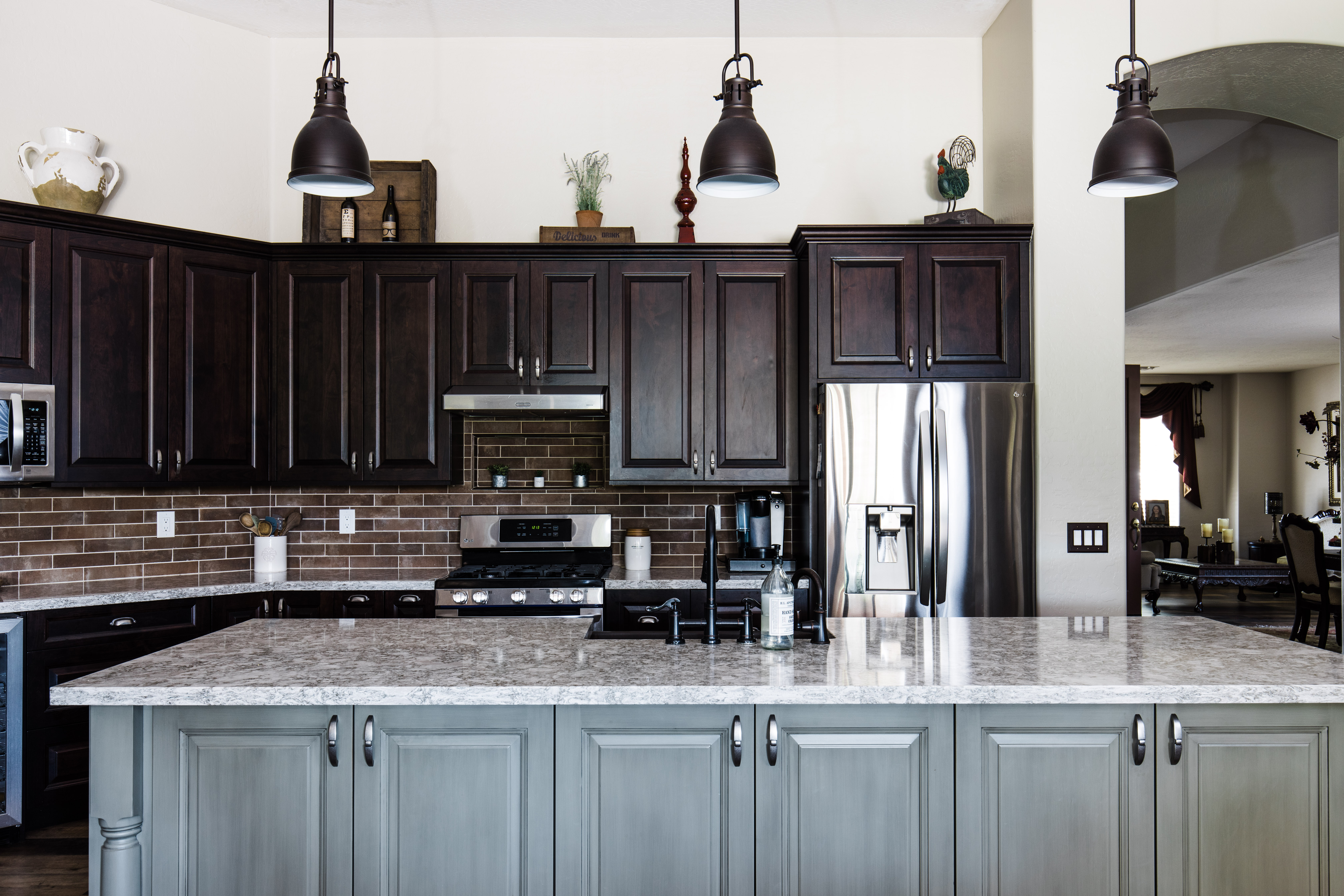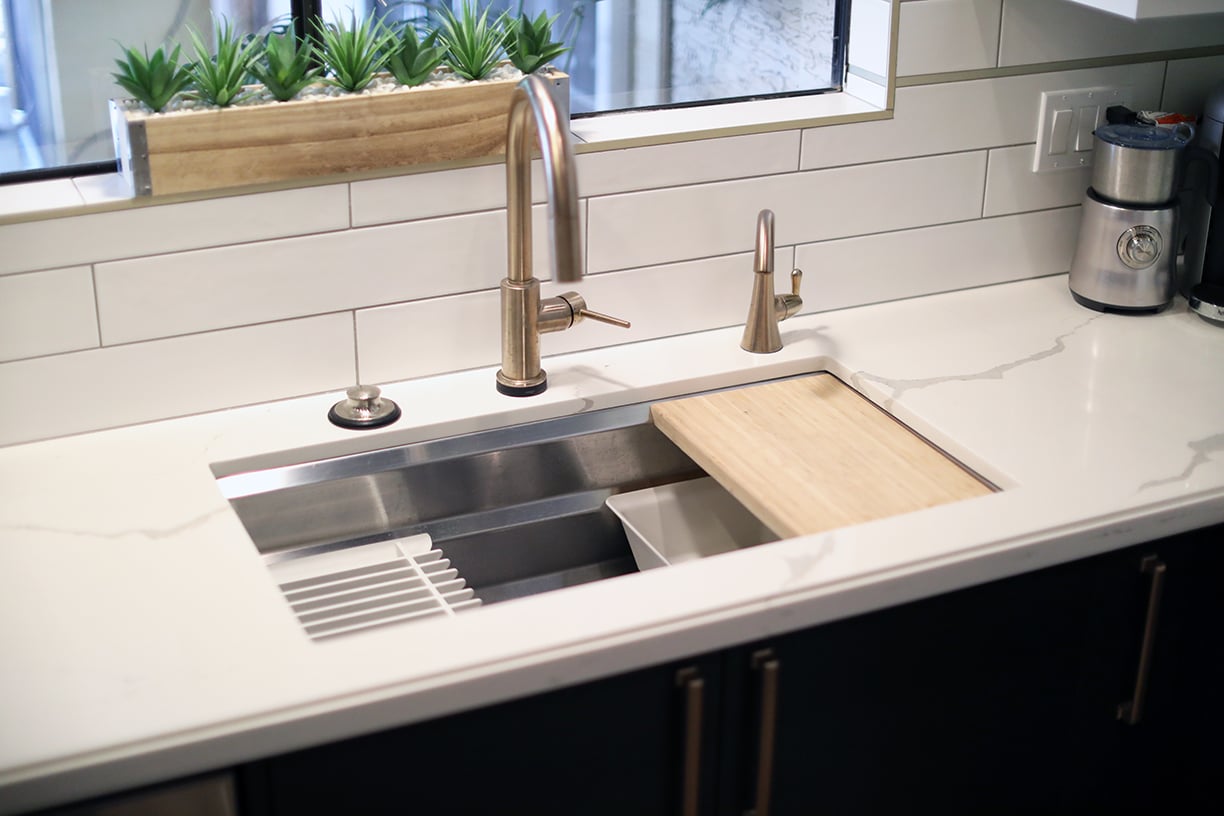6 min read
Designing a Functional Kitchen: Tips and Secrets for Success
Scott Hochuli October 17, 2023

In the realm of home design, creating a functional kitchen layout often holds the highest priority. It is not just a place for cooking and eating but also a hub for connection, creativity, and comfort. As we enter the middle of this decade, modern kitchen designs emphasize functionality and aesthetics in equal measure. This guide provides practical tips and inside secrets for designing a kitchen layout that combines efficiency, style, and comfort, ensuring it becomes the heart of your home.
Kitchen Design: Triangle vs. Work Zones
The traditional "work triangle" concept, which places the sink, refrigerator, and stove at three points of a triangle, has been a cornerstone of kitchen design for decades. This layout aims to minimize the distance a cook must walk to access these key areas. However, modern designs are shifting towards more dynamic 'work zones.' This approach involves defining separate areas for different tasks, like prep, cooking, and cleaning zones. These zones can be tailored to the users' specific needs and cooking habits, making the kitchen a more personal space.
The Truth about the Kitchen Triangle
Let's start by discussing the truth about the kitchen triangle. While it once was known as the "golden triangle" of design, kitchen designers no longer consider it a practical design technique due to the increasing trend of families cooking together. Having two people within the kitchen triangle becomes too crowded. Instead, we now focus on the 'work zone theory,' which divides areas of use into designated zones for efficient traffic flow. This approach allows for better functionality and organization in the kitchen.
Work Zones
Work zones in the kitchen are designated areas organized according to the type of work done in each.
- The food storage zone includes refrigerators and pantries where dry goods are kept.
- The tableware storage zone houses dishes, glasses, and silverware.
- The cleaning zone includes the sink and dishwasher.
- The preparation zone often consists of counter space for chopping and mixing.
- The cooking zone includes the stove, oven, and microwave.
Having said that, the key to a great kitchen design is that it reflects your kitchen habits. If you love baking, for example, you might want to create a separate baking zone with your mixer, baking utensils, and baking ingredients all in one convenient location.

Project: Chandler Kitchen Remodel
Adapting Work Zones to Different Kitchen Sizes and Shapes
Adapting work zones to different kitchen sizes and shapes necessitates a strategic approach that maximizes available space, enhances kitchen flow, and accommodates the user's specific needs.
Small Kitchens: Work zones must be cleverly designed to optimize limited space in small kitchens. The key idea here is to aim for compactness and multi-functionality. For example, the food preparation zone could be positioned at the end of a counter closest to the stove, doubling as a cooking zone. Overhead and corner storage solutions can expand the tableware storage and food storage zones.
Galley Kitchens: In galley kitchens, characterized by a long, narrow layout with cabinets and appliances on either side, it’s best to arrange work zones linearly to facilitate ease of movement. The cooking and cleaning zones can be placed on one side, while the storage and preparation zones are on the other.
Open Concept Kitchens: Open concept kitchens offer more flexibility in arranging work zones. However, they also need to maintain aesthetic harmony with the rest of the living area. An effective approach is to subtly integrate the kitchen appliances and storage into the design, keeping the cooking and preparation zones towards the central part of the kitchen to reduce noise and odors in the living spaces.
Related: Space Planning & Design: How to Make Your Kitchen Work For You
Project: Gainey Ranch Kitchen Remodel in Scottsdale
Maximizing Countertop Space
Maximizing countertop space is a crucial aspect of kitchen design. A generous counter space facilitates food preparation, serving, and even socializing, making it an essential component of a functional kitchen layout.
When designing your kitchen counter space, consider the following:
- Determine the Required Counter Space: The first step is to ascertain how much counter space you'll need for the cooking you do and how many people are typically involved.
- Use Islands and Peninsulas: Kitchen islands and peninsulas provide additional counter space and serve multiple functions, from food preparation to dining and storage. They also make great focal points in open-concept kitchens.
- Incorporate Clever Storage Solutions: By integrating smart storage solutions, like dedicated knife drawers and appliance garages, you can reduce clutter on your counters and increase your usable counter space.
- Consider Appliances: Built-in or under-counter appliances, like microwaves, beverage refrigerators, and ice makers, can free up counter space and create a streamlined look in your kitchen.
Remember, the goal is to balance having enough countertop space for efficient cooking and ensuring the kitchen does not feel overcrowded.
Designing for Comfort
Ergonomics plays a vital role in kitchen comfort. It involves designing the kitchen layout to minimize strain and unnecessary movement and enhance ease of use. Key considerations include maintaining appropriate counter height and depth, ensuring good lighting, and arranging appliances and storage at a reachable height. Accessible design features, like drawers and pull-out shelves, can also enhance comfort and functionality.
In the realm of practical features, considering elements like a pot filler near the stove, a pull-out trash can near the food prep area, or a pull-out organizer for cutting boards and cookie sheets, can make the kitchen more user-friendly.
Also, the choice of materials can significantly affect comfort. For example, anti-fatigue flooring can be easier on the feet during long cooking sessions, while easy-to-clean surfaces can make kitchen maintenance less of a chore.
Storage Space for a Functional Kitchen
Adequate storage is essential for a functional and organized kitchen. However, having too much storage can sometimes lead to unused spaces and inefficiency. Incorporating various storage solutions, such as upper and lower cabinets, pull-out drawers, and organizers, can help you make the most of your available space and keep your kitchen clutter-free.
Here are some practical storage options to enhance your kitchen’s functionality.
Upper and Lower Cabinets
Upper and lower cabinets are a staple in kitchen design, providing ample storage space for dishes, cookware, and pantry items. Utilize both types of cabinets, including upper cabinets, to maximize your storage capacity and keep your countertops free of clutter.
To optimize the functionality of your cabinets, consider adding pull-out drawers inside the lower cabinets. This allows for easy access to items stored at the back. Additionally, you can enhance the aesthetic appeal and accessibility by incorporating short glass-door cabinet doors. These can display decorative items or frequently used dishes, adding visual interest to your space.
This custom cabinet pull-out drawer holds all the utensils needed. Project: Kitchen Remodel in Phoenix
Custom Storage Options
There are many custom cabinet storage options for specific storage needs. Some of our favorites include:
- Blind Corner Organizers: Utilize the dead space in blind corners and reclaim valuable storage with custom organizers. This type of storage is perfect for bulky items like cookie sheets, cutting boards, or pantry items.
- Lazy Susans: These rotating shelves make it easy to reach items stored in the back of corner cabinets without rummaging through multiple layers.
- Spice Racks: These handy racks come in a variety of styles and placements, but no matter the design, they help consolidate all your spices into one easy-to-access location.
- Knife Drawer: This custom-designed storage solution is perfect for organizing kitchen tools and keeping your countertop clutter-free.
- Charging Drawer: Charge your devices and keep them out of sight in one convenient drawer.
By incorporating these elements into your kitchen design, you can create a functional and organized space that is both aesthetically pleasing and user-friendly.
Modified footprint from the original to accommodate this new coffee bar area. | Project: Alta Mira Kitchen Remodel
Creating a Social and Family-Friendly Space
A kitchen should be more than just a functional space for cooking; it should also be a social and family-friendly environment where memories are made. By incorporating open-concept layouts, kid-friendly design elements, and entertaining spaces, you can create a welcoming and enjoyable family room for everyone.
Open Concept Layouts
With better airflow, ventilation, and natural light, open-concept kitchens have become popular in modern homes. They are designed to enhance your kitchen’s social atmosphere by creating a spacious feel and encouraging interaction between family members and guests. By removing walls and barriers between the kitchen and other living areas, you can create a more connected and inviting space, perfect for entertaining and spending time with loved ones.
Kid-Friendly Design Elements
If you have young kids or grandkids, incorporating kid-friendly design elements into your kitchen can make it a more enjoyable and safe space for the whole family. Consider lowering countertops to accommodate children and creating designated areas for them to help with meal preparation or homework.
Additionally, prioritize safety features such as rounded edges, slip-resistant flooring, and child-safe locks on cabinets and appliances. Designing a kitchen that meets the needs of all family members fosters a sense of togetherness and encourages quality family time.
Entertaining Spaces
If you entertain frequently, designing entertaining spaces in your kitchen can make hosting gatherings and spending time with friends and family a breeze. Breakfast bars and seating areas around the kitchen island provide comfortable spots for guests to relax and chat while you cook.
You could also create a designated coffee/beverage bar with a mini refrigerator, which makes it easy to serve drinks or allow your guests to help themselves.
Creating a functional kitchen layout is crucial for an enjoyable cooking experience and fostering a welcoming environment for family and friends. You can design the perfect kitchen that meets your unique needs and preferences by considering factors such as the work triangle, work zones, appliance placement, counter space, storage solutions, lighting, and materials. So, go ahead and unleash your inner chef in the kitchen of your dreams!
Are you ready to make your house the perfect home? Meet our team and then contact us to discuss your project. We’d happily design a functional kitchen for you to love and enjoy!
